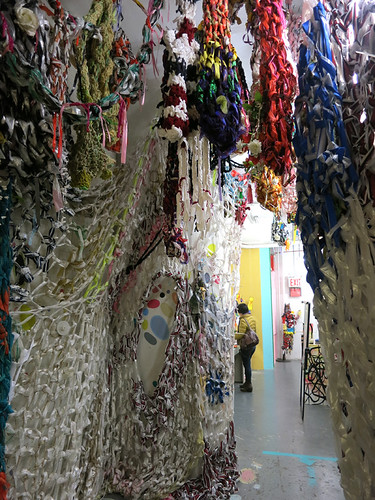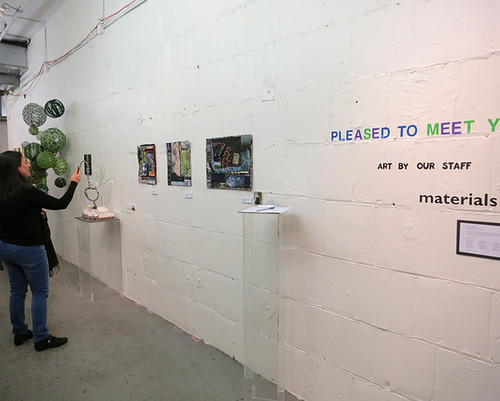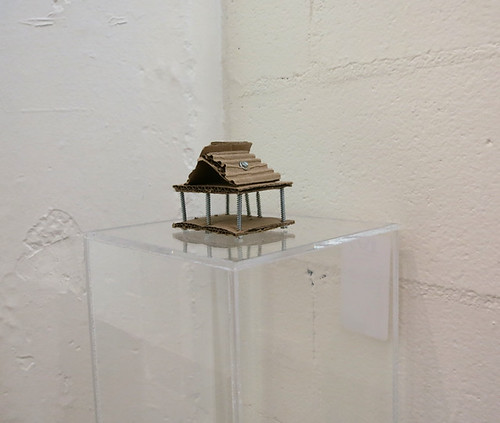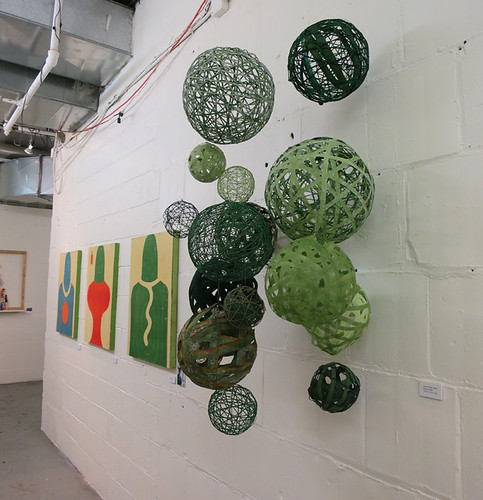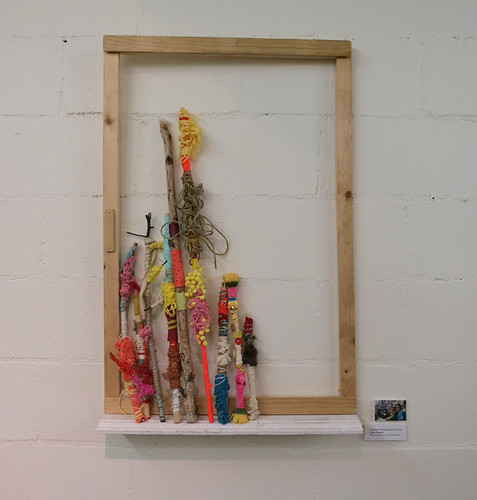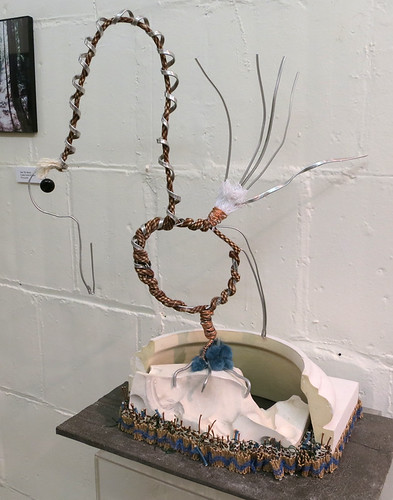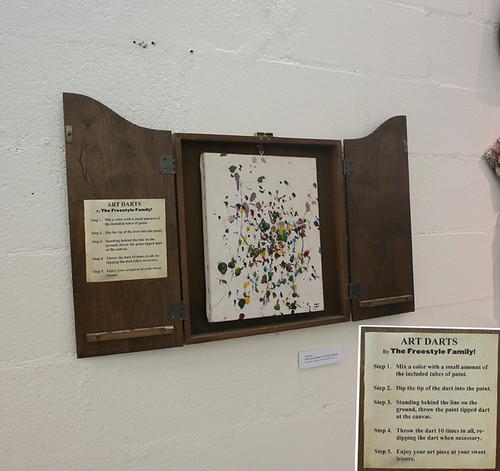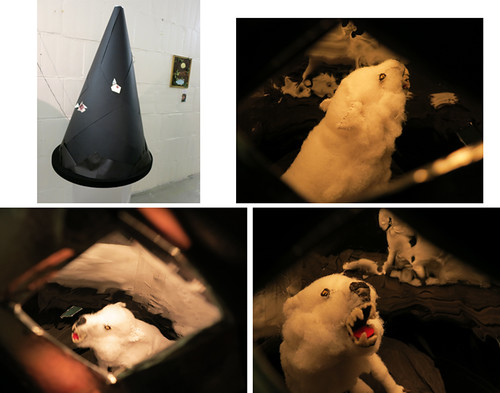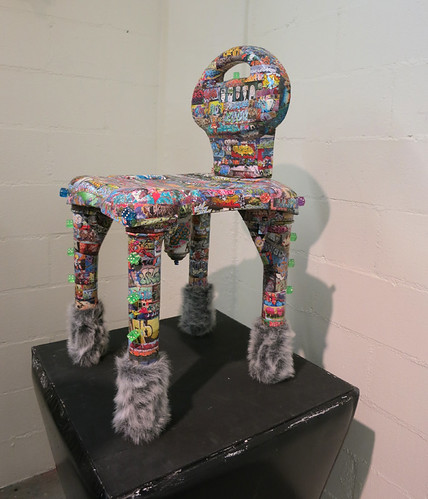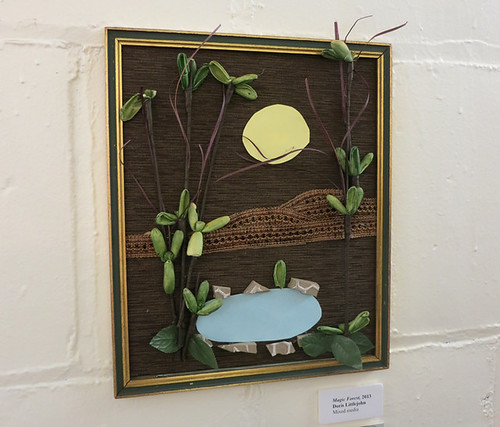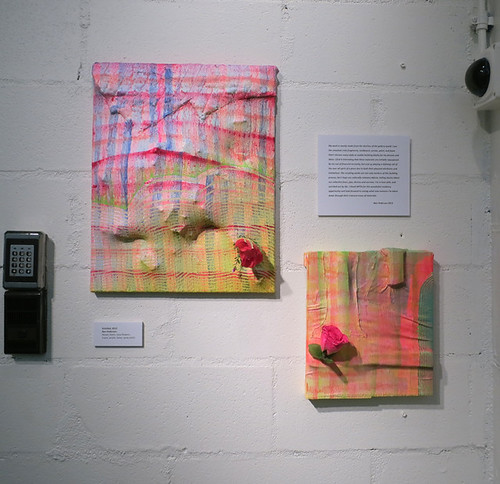I have been excited to publish this post since the first moment I had the idea to do these interviews. Partly this is because printmaking is one of my other loves besides fiber art, but mostly it is because I have followed and admired Lexi Babayan's artwork for a long, long time. In fact, I first met her when I was five years old, and I have seen her create great art for more than a quarter of a century.
You can see more of Lexi's work in her Etsy Shop OR in her Flickr Photostream, where you have the added benefit of getting to see images of works in progress and demonstrations of her carving and proofing processes.
Lexi has shared some fascinating and very specific details about how she makes her art, and while she is a printmaker and many of my readers work in other disciplines, I think these insights will have a great appeal and relevance for fiber artists, since we also focus deeply on the physical processes we use to create our work.
Describe Your Workspace - is it in your living space or separate? Do you have a preference one way or the other? Is there anything your setup doesn't allow or that you have to do in a weird way? Have you come up with any ridiculously clever ways of working with the space you have available to you?
My workspace is in a freestanding garage, a few paces away from the house. I share the space with my artist housemate, Barry Ebner. We are both printmakers. He had already converted the garage into studio space well before I moved in. I have my worktable in the corner, and I sometimes expand onto the larger central table, especially when printing. When I am carving a block, I usually set a wooden crate on top of the table, and the block on top of that-- that brings it up to a more ergonomic height. (Low-tech, yet effective.)
 |
| Brayers with ink |
Barry came up with a ridiculously clever, incredibly simple, drying rack solution. He made some simple rectangular wood “frames,” each covered with window-screen mesh. These can be stacked up to about twenty high. The wood strips create a gap between each layer, so nothing touches the face of each print, and the mesh allows air to circulate.
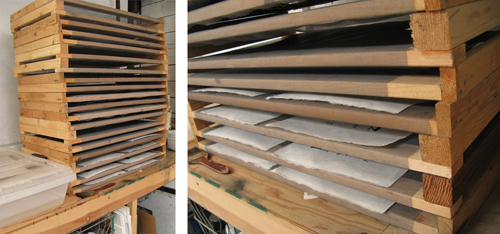 |
| Clever drying racks made from cheap, available materials |
I definitely value having an art space where I can get a bit messy, and where I can leave works-in-progress sitting out, ready to be resumed at a moment's notice. This is less practical when one's only working space is in one's bedroom. (I have been in that situation before, a small bedroom at that. It is no coincidence that I made very small-scale works at that time. Also, I made use of clotheslines stretched across the bedroom as drying racks. Then, as now, I was using oil-based printing inks, which take quite a while to dry.)
 |
| Ink ready to roll out |
Would you say your personal style runs more towards clutter or organization? Does your style work for you, or are there elements of it you wish you could change?
I tend to accumulate things. I continually struggle with shifting my disorganized piles of things into “more organized” piles. “Organized clutter” appears to be my norm. A non-cluttered environment does not seem to be an option for me! A clean, Zen-like space with lots of empty surfaces sounds lovely but unattainable... but it could be that a cluttered environment stimulates my creativity in some secret way.
 |
| Lexi's workspace with image being transferred to a wood block |
Do you ever have to choose between doing some aspect of your work "the lazy way" versus "the better but far more annoying way," and has going for "the lazy way" ever produced unexpectedly awesome results?
This may sound perverse, but I tend to work in the most labor-intensive methods available to me! However, this is because I enjoy those labor-intensive methods. I create meticulously detailed, hand-drawn, hand-carved, hand-printed woodcuts, frequently multicolored, in a method that requires that a separate block be carved for each color. Not only that, but most artists, when faced with depicting a brick wall, will try to suggest bricks without drawing every single one. Trying to draw every brick is a crazy maneuver, generally only attempted by particularly driven and obsessive self-taught artists. I like to carve out every brick in a brick wall.
 |
| Every brick carved by hand |
There is a rhythm to carving them out, “brick, brick, brick,” similar to the “stitch, stitch, stitch,” of knitting a scarf. (I am talking about bricks here, but the same is true of other repetitive patterns I may incorporate into a piece.) Ultimately, this seems to create a buzzing vibration across the surface of the image.
 |
| “MJB Coffee WHY?” woodcut by Alexis Babayan |
I will say, however, that the fact that I need to carve a separate block for each color leads me to think whether every color in the image is strictly necessary... For instance, can I use just two colors and make it “feel” like a full spectrum? Can I declare, for the purpose of one image, that “green” is actually the same thing as “black?” A limited palette can help to create very strong, energetic-feeling images. This is where the physical difficulty of making the image helps me to pare it down to the essentials.
 |
| “Easy Liquor/ Best Fire” woodcut by Alexis Babayan |
Are there any particular patterns or motifs that creep into your work when you're not paying attention, and have you given any thought to where they might come from?
I seem to be very partial to the color of rust, and I take particular pleasure in knowing that the pigment in my rust-colored ink is a form of iron oxide and hence chemically the same as rust! That color is particularly beautiful against a vibrant blue or turquoise, and I tend to seek out scenes that include those ingredients. I like certain repeating patterns, like brick walls and chain link fences. I also like things that break up patterns, like weeds growing through cracks in the concrete. When I am drawing absentmindedly while thinking of something else, I nearly always draw human forms and faces. My “serious” art, these days, rarely includes human figures. However, it nearly always includes indirect signs of human presence.
 |
| “Read a Book” Woodcut by Alexis Babayan |
Are you a stickler about your particular medium, or are you happy to cheat, borrow and steal from other disciplines whenever it seems like a good idea?
I am a stickler about “making things by hand” but I am not so much of a stickler when it comes to what particular raw materials I use. Sometimes I carve into wood, sometimes I carve into linoleum. Both are “relief printmaking” and I consider them to be basically the same thing, though the different materials have different strengths and weaknesses. The major difference is texture: linoleum has no grain. This can be helpful in images with lots of tightly curving lines. (Wood has a strong opinion about how it wants to be carved, and objects to curlicues that go against the grain!) However wood generally “feels” nicer to carve, and the wood grain often creates happy accidents that couldn't happen any other way. Sometimes I will use both wood and linoleum for different layers of a multi-block print.
 |
| “Union Machine Works” Woodcut and linocut by Alexis Babayan |
Have you ever spent Way Too Much on some exciting new art-making tool and it ended up being the best idea ever? (tell us the story!) Alternately, have you ever done the same thing and it did NOT work out at all? (give us all the gory details!)
I spent a lot of money on a really nice large brayer, imported from Japan. Later on I bought a small one of the same type. (Like these: http://www.imcclains.com/catalog/brayers/japanese60durometer.html They are even more expensive now than they were then, but eventually I want to acquire another one!) It was worth it to me. The thing is, the inexpensive soft rubber brayers you get from Speedball work quite nicely for most purposes. (Those are the ones you can find in just about any art store.) Speedball also makes a hard rubber brayer, which is almost completely useless—it will slide around on the ink rather than picking it up evenly. These brayers are firmer than Speedball's soft brayer but softer than Speedball's hard brayer. Because they are on the firm side, they discourage over-inking. They are exactly the right texture for emphasizing wood grain and retaining fine detail. The larger width and diameter help to apply the ink evenly. If you see my working set-up, you will find that I often have three or four brayers in use simultaneously with different colors of ink. I've got the two Japanese brayers and an assortment of Speedball soft rubber brayers.
One time, I ordered a “nice” chisel from Daniel Smith that cost twenty-some dollars. (I had a gift certificate that was burning a hole in my pocket.) It is nice and sharp and the blade is a good shape, but the handle just doesn't feel comfortable in my hand so I almost never use it. I greatly prefer my Power Grip tools, which cost about eight bucks apiece.
The least expensive art tool which I use regularly (and which I love,) is a bamboo rice paddle which I bought from a Chinese grocery store for about one dollar. I use it as a baren (burnishing tool for hand printing.) I like it better than “official” barens that I have tried. I even prefer it to a multi-thousand dollar printing press!
 |
| The rice paddle magically brings the print to life! |
Are you currently having a passionate love affair with a particular medium or technique or concept, and would you care to share all the steamy details?
I am passionately in love with both my medium (woodcut printmaking) and my subject matter (urban street scenes and signage.) We have been together long enough that we should really be considered to be married under common law!
Describe your sketchbook (or other Vital Idea Capturing Aparatus). Do you work in such a way that there is a great distance between sketches and finished projects, or are you more likely to incorporate your sketches directly into your final work?
I use a camera for the initial stage of image-gathering. My current body of artwork would not exist were it not for my habit of taking long walks accompanied by a camera. Sometimes I use a heavy old 35mm film camera that used to belong to my grandfather. I like the ritual of using it. Other times I use a digital camera, for expediency. The photos do not become part of the final piece, they are part of my own personal documentary project. Later on I make drawings based upon some of the photographs. Usually those drawings are not in a sketchbook, but on various stray pieces of paper. I change up my drawing methods: sometimes I work out my drawing in brush and ink, other times regular graphite pencil, other times white pencil on black paper, or whatever drawing tool feels right at the time. I choose which elements to emphasize and how to translate the image into the printmaking medium. Often I end up re-drawing my image on trace paper, for ease in transferring the image to a woodblock. As I carve the image into the block, there are still things that need to be edited and decisions that need to be made. The process is still “alive.” I am not just duplicating my earlier sketch. I keep my photograph nearby as I am carving the block. I also use a small mirror as an extremely useful “wireless graphics tool” (marvelous for reversing images.)
 |
| Carving tools and mirror |
Do you ever find yourself anthropomorphizing the media you work with or a particular aspect of your process?
Yes. I work with a lot of very sharp tools, and I have a theory that if I treat them with respect they will serve me well and won't cut me. If I ever disrespect them, or act blasé about their abilities, they will probably turn upon me and cut me. In general, my tools and I have a very good working relationship.
What is the best thing about people bringing their own unique interpretations when they interact with your work? Also, have you ever heard someone's interpretation of something you made and thought to yourself, "Gee, I'm not sure where you got that one, but I wish you'd toss it back where it came from!"?
I work with some very specific local landmarks in my art, so that provides an entry point to conversation that wouldn't be there if my work was more abstract. Someone who grew up in the neighborhood can talk about their memories and feelings about a certain place, about local history, and about scandals that happened a long time ago! However, it irks me when someone just tells me that my work is “funny.” It has an element of humor, but that is mixed in with other elements, such as finding genuine beauty and pathos in unexpected places.
 |
| “Lite House” Woodcut by Alexis Babayan |

